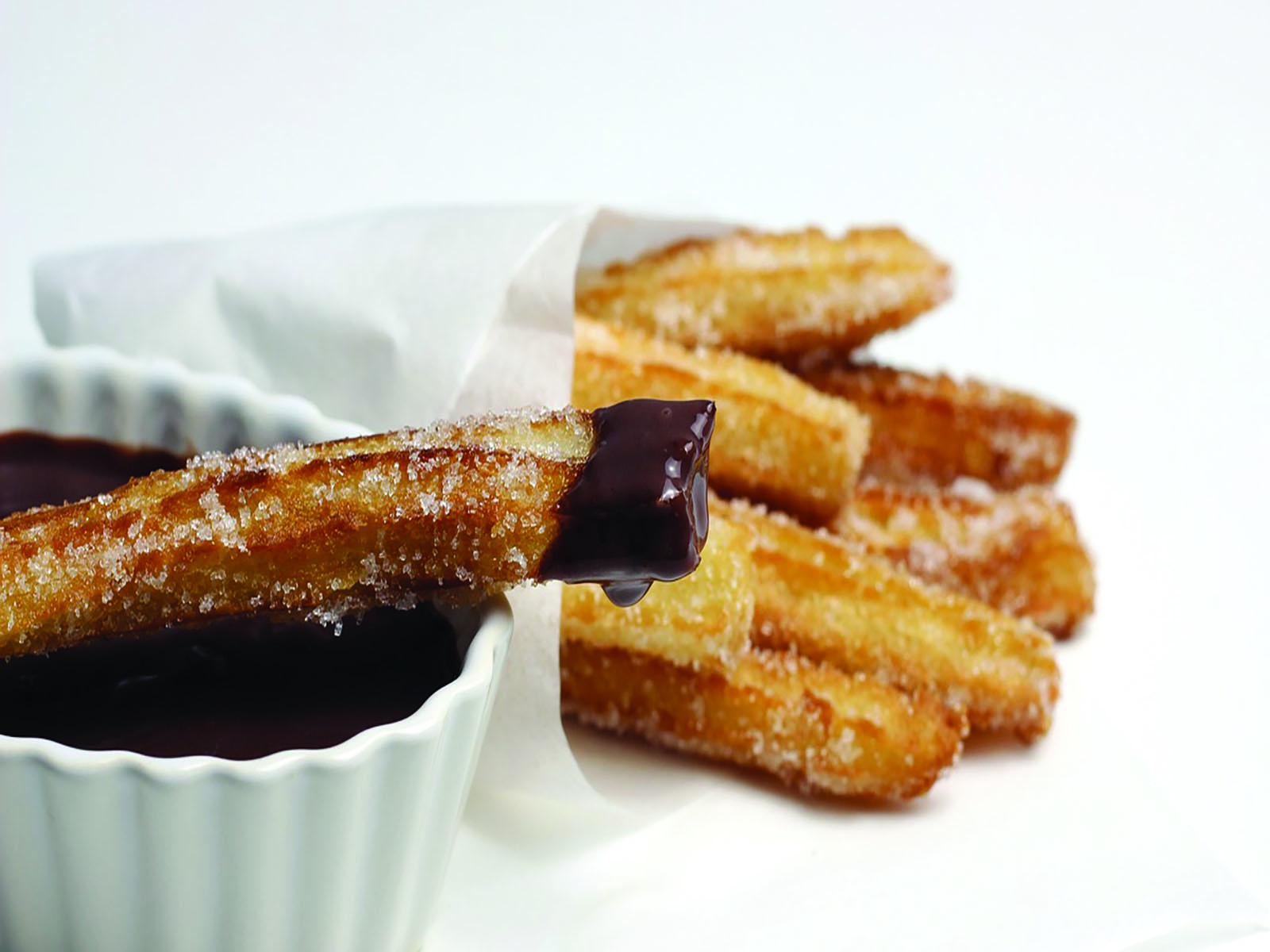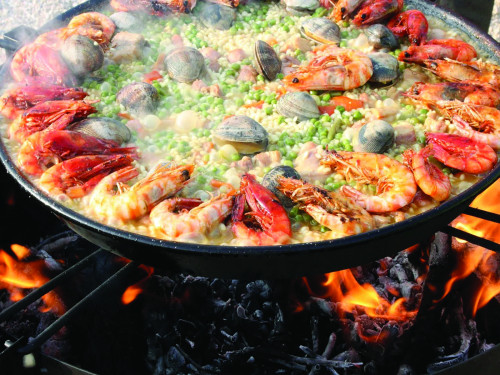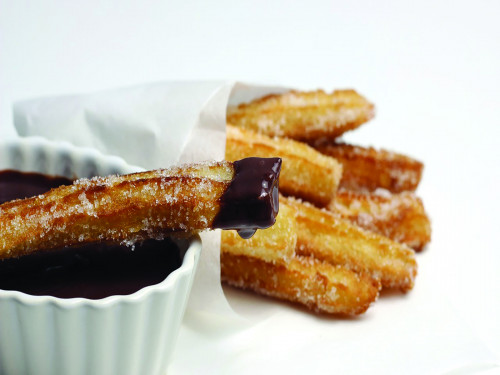Eating Out In Axarquía
Eating out in Axarquía is one of the first things that strikes visitors and new residents to Southern Spain is the eating hours; they are much later than we are used to in the UK. In fact, it can be a frustrating thing when you visit a bank or office mid morning and discover that the person you need to see has gone out for breakfast - a sacred ritual which can take place anytime between about 9.30 and 11 a.m.
Equally lunch is typically not eaten until 2 or 3 p.m. For this reason, having a tapa around midday will help you to last until you can finally eat lunch, or tapas can be eaten as a lunch in themselves.
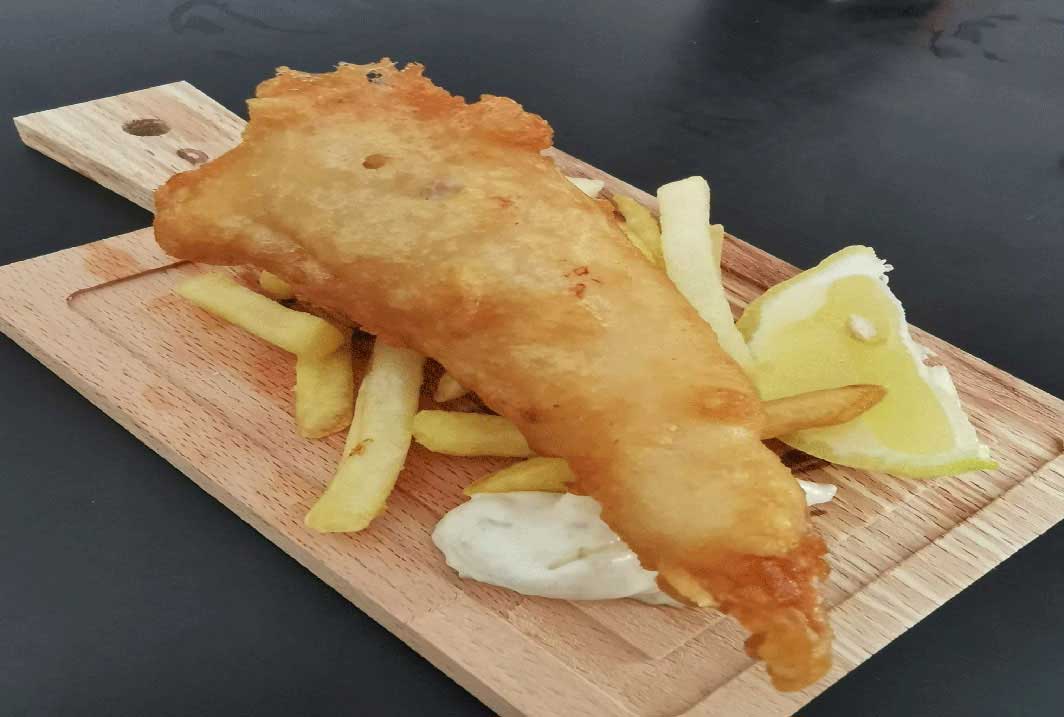 Fish and chips tapa at Bar Samba, Torre del Mar
Fish and chips tapa at Bar Samba, Torre del Mar
Tapas
When we think of eating out in Andalucía, or even of going out for a drink, tapas immediately spring to mind. Many bars advertise a special price for a drink such as a “caña” (small beer) and tapa, and what better way to enjoy a drink with friends than to pick at a snack at the same time? Especially something more interesting than a bowl of salted peanuts or a few crisps!
The word “tapa” comes from the Spanish word for a lid. A tapa is a small portion of food on a saucer sized dish, and can be anything from a cold salad or “ensaladilla” (cold vegetables combined with mayonnaise) to hot stews or combinations to accompany your drink. If a tapa has whetted your appetite, you may order a larger portion - a “media-ración” or even a full plate of what you fancy - a “ración.”
Here are some typical favourites:
Esaladilla rusa - vegetables, egg and often tuna bound in mayonnaise
Salpicón de marisco - seafood salad
Boquerones - White anchovies in vinegar and garlic
Magro con tomate - pork stewed in tomato sauce
Pinchitos - small skewers of spicy meat
Patatas bravas - cubes of fried potato with a spicy sauce
Tortilla - spanish potato omelette, served hot or cold
Empanadillas - like pasties filled with meat or tuna
Huevos rellenos - stuffed eggs
In most bars you can see a list of tapas on a menu or blackboard or simply get up and have a look in the chiller on top of the bar for that day’s selection. Tapas are normally served with baguette style bread or small bread sticks.
In the evening, dinner is rarely eaten before 9 or 10 p.m. whether at home or in a restaurant and it is unusual to be able to order a meal before 8 p.m., so an evening drink accompanied by a tapa is a welcome snack. Alternatively you can make a meal from a selection of tapas and share them between friends.
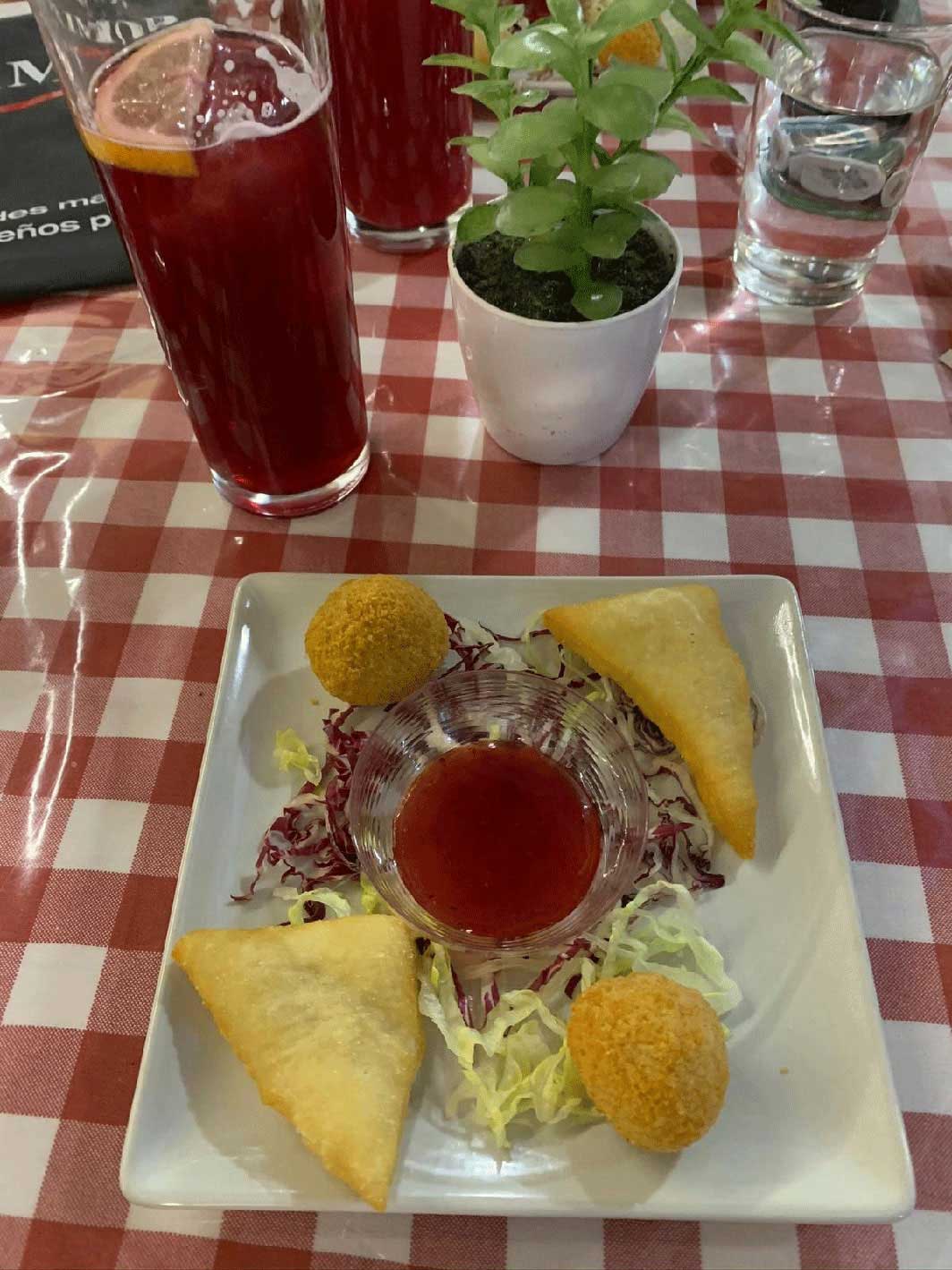 Selection of tapas at Buon Gusto, Torre del Mar
Selection of tapas at Buon Gusto, Torre del Mar
Jamón Serrano:
Many bars will have a whole leg of pork on the bar, held in a special stand called a jamonero. There is a special skill to cutting wafer thin slices from the “jamón”. These may be served to accompany a drink, as a dish in themselves with slices of manchego cheese, or in a sandwich such as a breakfast “pitufo” (small toasted vienna). If you order a pitufo a la catalana you will receive the bread smeared with olive oil and crushed fresh tomato, and topped with several slices of Serrano ham.
This is not to be confused with jamón york, which is boiled ham of the type you buy in a packet.
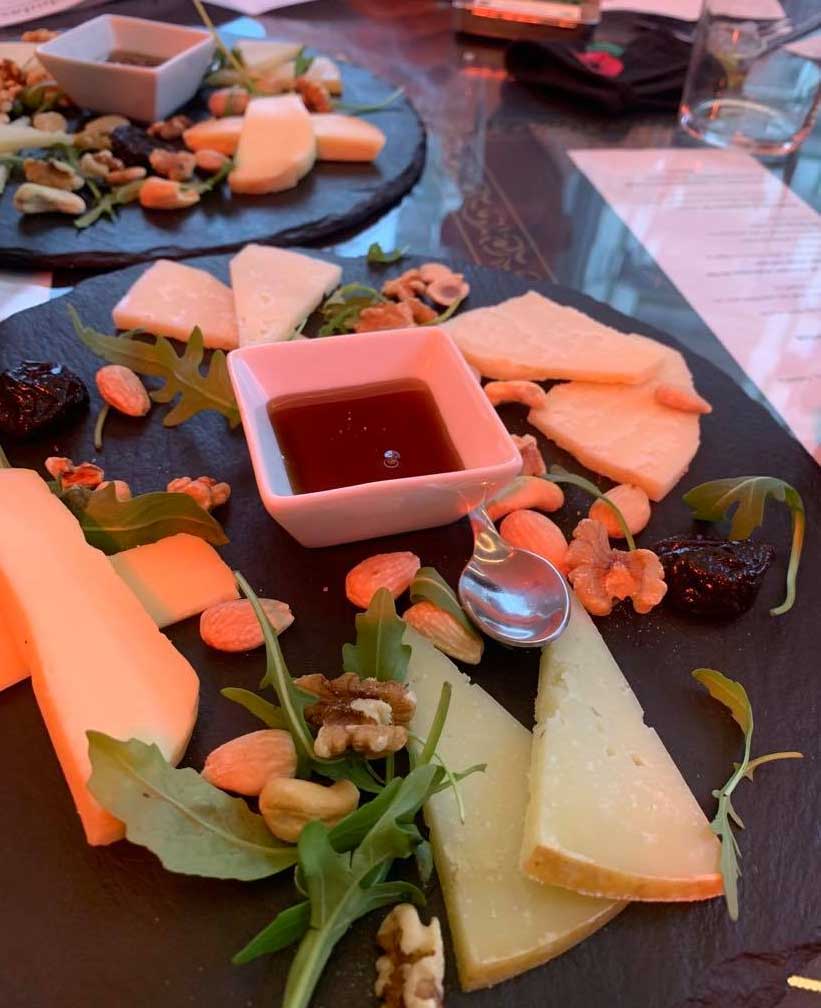 Manchego cheese tapa
Manchego cheese tapa
Chiringuitos
When lunchtime arrives, there is so much to choose from. If you are near the sea, the selection of fish and seafood available is incredible. The Costa del Sol is famous for its beach bars called chiringuitos where it is a common sight to see a fire burning outside and a chef cooking fish on skewers over the smoking glowing olive wood. Sardines - sardinas - are cheap and absolutely delicious, sprinkled with salt and cooked on metal skewers out in the open air. But the range of other fish, grilled or deep fried, and seafood such as mussels (mejillones), cockles (berberechos), deep fried anchovies (boquerones), squid (rabas or chopitos), calamari and octopus (pulpo) can be almost overwhelming. Pescaito frito means fried fish in Spanish, and few Andalucians can resist.
Gambas pil pil is a firm favourite in the chiringuito - sizzling hot prawns cooked in olive oil with garlic and chilli. You have to share because everyone present will want to dip their bread in the gorgeous oily sauce.
In fact, whatever you order will be brought out to you in the order in which it is ready, and the staff will tend to assume that all diners are going to share.
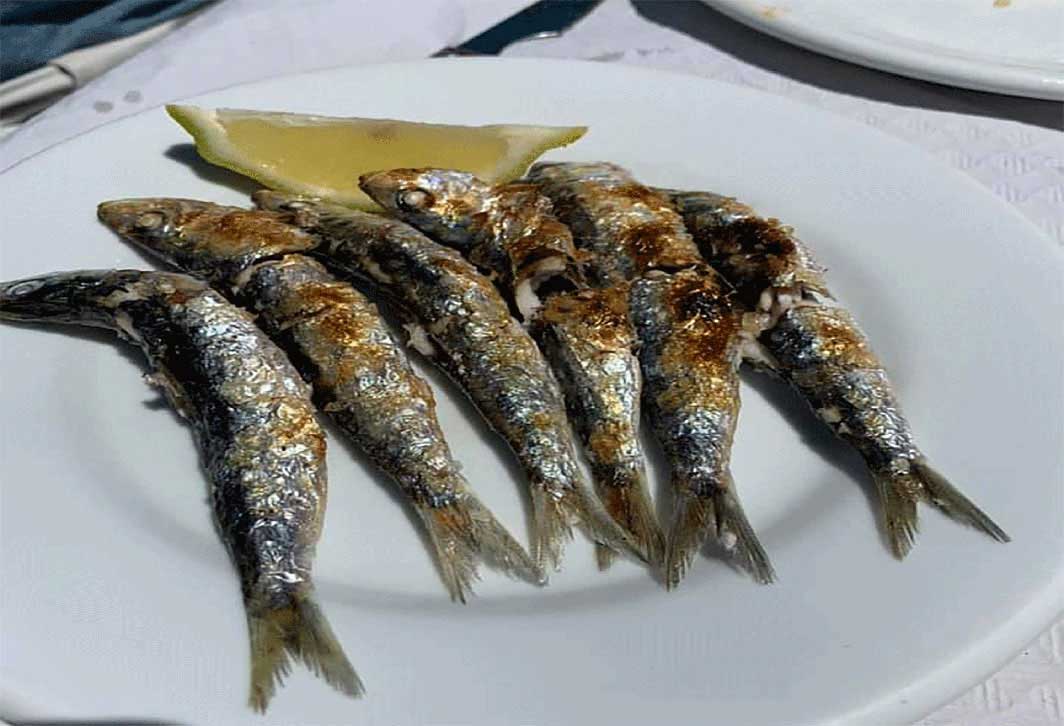 Sardines from Chiringuito Tropy in Caleta de Velez
Sardines from Chiringuito Tropy in Caleta de Velez
Paella
There is more than one type of paella, but near the coast you are likely to find a seafood one. Many restaurants have a special day for paella and will make a huge one, starting at maybe 11:30 in the morning. You can watch the progression of the paella and then sit down and have a drink while it cooks slowly in an enormous pan called a “paellera” which is the size of a small table.
However paella can be made with all sorts of meats such as chicken, pork or rabbit as well as fish and shellfish.
But we must not forget all the other different types of rice on offer in our restaurants. They would make a topic in themselves, each having its distinct origins and frequently a story relating to how it got its name. Arroz a la Banda (translated as “plenty of rice”) consists of rice, saffron, garlic, shellfish and fish stock. You can also order black rice which takes its colour from squid ink, and many other rice dishes.
Cold soups and Purees
Everyone has heard of gazpacho, but there are many other cold purees which are worth a try. Salmorejo is made from tomato, garlic and bread which is made into a puree which is often garnished with diced hard boiled eggs or Serrano ham. Broadly similar is porra which is often so thick that it is served as a tapa, like a dip, sometimes with little breadsticks. Gazpacho, depending on which area you are in, can be anywhere between thick and almost dip-like, and watery like a cold soup. You can buy gazpacho in cartons in the supermarket, but there is nothing like the real thing, freshly made and served on a hot day.
“Spoon dishes”
You will often see a section on menus called “platos de cuchara”, which means dishes to be eaten with a spoon, and this can include all manner of soups and stews. Puchero could mean just about anything as this dish takes its name from a large cooking pot. Generally speaking, pucheros and other stews contain pulses; like many dishes, their origins are very humble and the idea was to use whatever was at hand, cheap and/or filling to make what was originally a poor man’s dinner. You can find all sorts of things floating around in your bowl, from chick peas to lentils and white beans (alubias blancas), other pulses and legumes including habas (broad beans).
You will see names like guiso, cocido, caldero and potaje too. Read stew or casserole in each case.
And don’t forget pisto, which is similar to a ratatouille, often served with egg in Andalucía.
Spoon dishes contain different meats and sometimes also callos (tripe) or chorizo. Ordering the same dish in two different towns or villages could easily present you with two entirely different meals. If your nose turned up at the thought of chick peas, wait until you try them with spinach (espinacas). And although the word tripe might not be too appetising - a bit like conejo (rabbit meat) - remember that the Spanish have been thriving on these meals for decades with no ill effects.
Menú del día
Many restaurants offer a daily special meal which is normally three courses, and it is available only at lunchtime. Lunch is of course the main meal of the day in Spain. In fact the word “lunch” which translates to almuerzo is very rarely used; while we are taught that comer means to eat, in reality it is more likely to be used to indicate having lunch, while desayunar is to have breakfast and cenar is to have dinner, not that dinner is much of a meal if eaten at home since lunch is such a substantial meal for most.
Apparently the name menu del día was coined by Franco himself who is said to have designed a set tourist menu back in the 1960s as the tourist industry started to take off. In 1965 a law was passed requiring many restaurants to offer a set menu at an affordable price to showcase Spanish cuisine to tourists. It soon became a firm favourite for workers who were unable (or perhaps decided that they did not want to!) return home for lunch. It usually includes water, bread, a dessert and a drink such as a glass of wine or a small beer.
Prices are keen, choices are limited, but if you want to eat really well, the menu del día is likely to be great value.
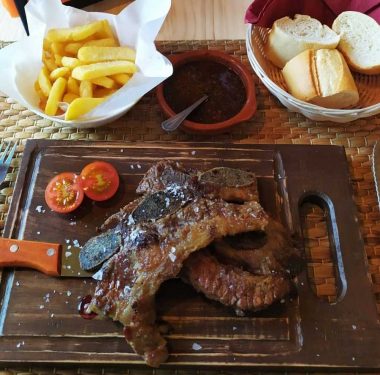 A meal from the Uruguayan Restaurant ‘Enjoy’ in El Copo, Torre del Mar
A meal from the Uruguayan Restaurant ‘Enjoy’ in El Copo, Torre del Mar
Meat
If the menu says “carne”, you can more or less guarantee that it is pork. And there are a myriad of cuts of pork available, such as secreto ibérico, cabeza de lomo and lomo (loin) itself. Meats may be in the form of a steak, meatballs (albóndigas) which could be cooked with many different sauces such as tomato or almendras (almonds) or served on a brocheta which is a long metal skewer.
Rabbit is widely eaten in this region although it tends not to be a particular favourite with British diners. And you have to decide for yourself whether you would like to order a suckling pig (cochinito) or not. You may assume that the pig will be brought in on a huge pole and laid out on the table in front of you, but most restaurants will cut it into pieces before serving it even if you have ordered a whole one to share between a party.
Vegetarian and vegan
Restaurants specialising in vegetarian or vegan cuisine are springing up now in Andalucía, and with more and more people choosing not to eat meat, fish or dairy products, this is a positive move.
There are many traditional dishes which contain no meat, such as pisto (ratatouille), many soups and cremas which are really just thick soups; pulses are used in so many dishes too. Having said that, most stews in traditional restaurants do contain meat.
Some really delicious vegetarian dishes include garbanzos con espinacas (chick peas with spinach) and berenjenas con miel (fried aubergines with honey), gazpacho and other cold soups and cremes, and some fabulous salads. Croquetas (croquettes) are usually absolutely amazing, but be sure to ask what they contain as they might assume that you don’t mind them containing chunks of ham for instance.
Most restaurants will try to accommodate you and make something special if you explain your dietary requirements. There are also now a multitude of wok style restaurants, Greek, Indian and Chinese where you can order without having to explain yourself. And for a special occasion, an internet search will produce results as veganism and vegetarianism increase in popularity.
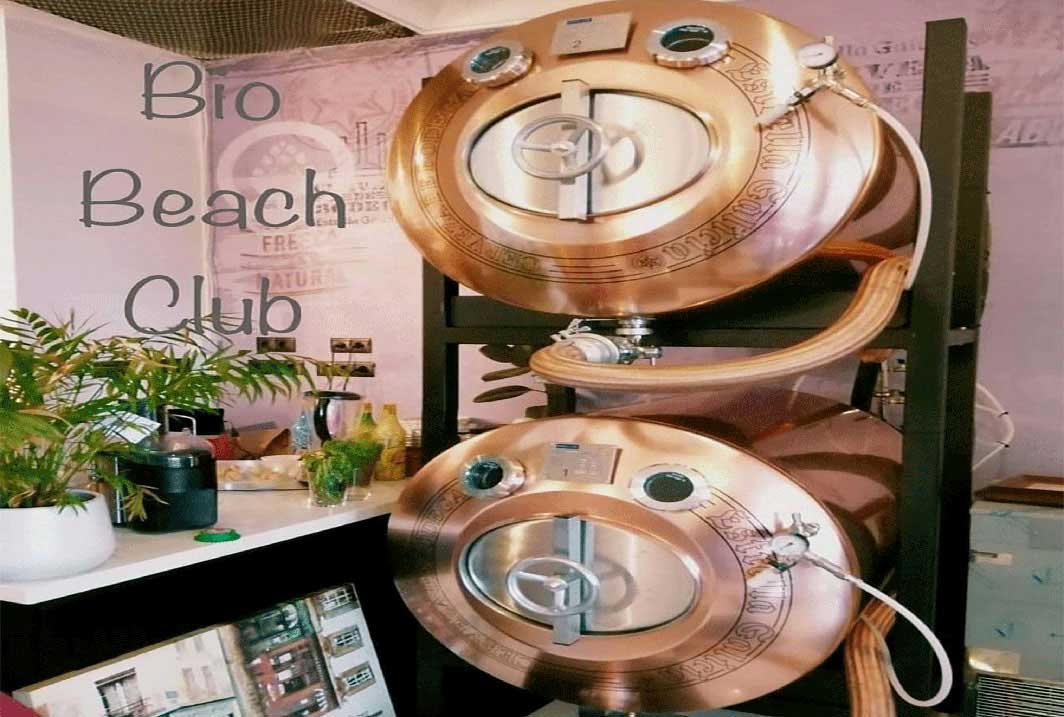 Bodega with premium beers at Bio Beach Club, El Morche
Bodega with premium beers at Bio Beach Club, El Morche
Bodegas
The word bodega means a wine cellar or wine shop, although many restaurants will call themselves bodegas too. Assume that any restaurant with this name carries some special wines.
Visit https://www.facebook.com/BioBeachClub
No article on Spanish cuisine would be complete without at least mentioning Spanish wine. Spain is the third largest wine producer in the world after France and Italy, and produces wines in two brand classifications, table wine (vino de mesa) and those produced in specific regions which are known as “Vino de Calidad producido en region determinada”. The latter will undoubtedly be of better quality and blended from fewer varieties of grape.
If you see D.O. on the label or wine list, this indicates the superiority of the product and is the Spanish equivalent of the French AOC (Appellation d’Origine Controlée). Some wines which you will have come across and should definitely try are the full-bodied oaky D.O. Ribero del Duero, and Rioja, also Sierras de Málaga, Toro, La Mancha and Ribera del Guadiana. These are all vinos tintos (red wines), and if only ordering a glass, remember that although vaso is the word for glass, in the case of wine we order a “copa”.
There are also rosados, rosé wines from those same regions which are worth sampling, and look out for white wines (vinos blancos) from Rueda, Sierras de Málaga and Ribiero.
Depending on how long the ageing process has been, wines will be Joven (young), Crianza, or if aged for several years, Reserva or even Gran Reserva. Prices rise accordingly.
We must not forget the amazing Spanish Cavas which mainly come from Catalunya. Although Cava has not yet managed to gain the same reputation as French Champagne, it is increasing in popularity internationally and in Spain itself of course. Look out for “método tradicional” on the label, which is an indication that the fizz has occurred through natural fermentation.
Andalucía, and particularly the Western part of the South coast is the home of sherry production, named after the city of Jerez. From a sweet sherry such as the famous Pedro Ximenez which is frequently used in sauces too, through the Oloroso and Amontadillo, to the driest Fino or Manzanilla, there is a sherry for every palate.
In this dry and frequently hot region, vines are often cultivated for pasas - loosely translated as raisins - from which the Moscatel wines are made. These tend to be dessert wines, sweet and sometimes almost like a liqueur. There will be an enormous difference between a Moscatel bought in a quite decorative bottle, and the almost “bulk” quality of the Moscatel you can buy or be presented with in large plastic containers in the countryside. Flavour of the latter will be very variable and the alcohol content will be anybody’s guess.
Finally, what could be more refreshing on a hot Summer day than a Tinto de Verano? A dash or red wine and gaseosa or lemonade will certainly quench your thirst perhaps even better than a cold beer.
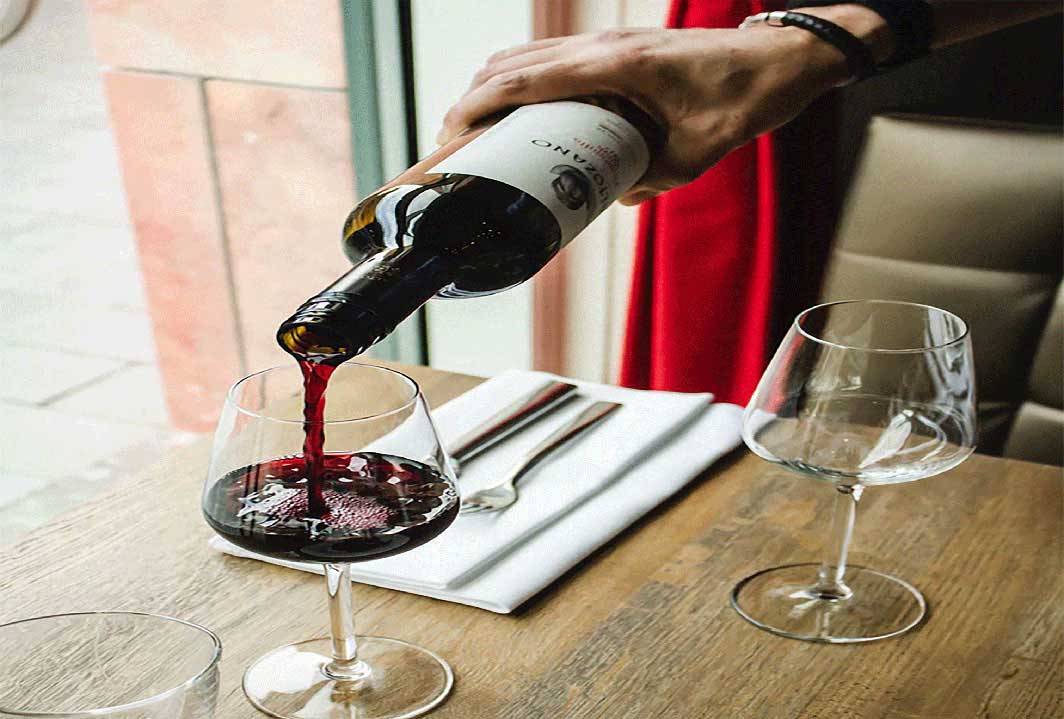 Wine... red, white and rose. Saludos!
Wine... red, white and rose. Saludos!


 Danish
Danish Dutch
Dutch French
French German
German Spanish
Spanish